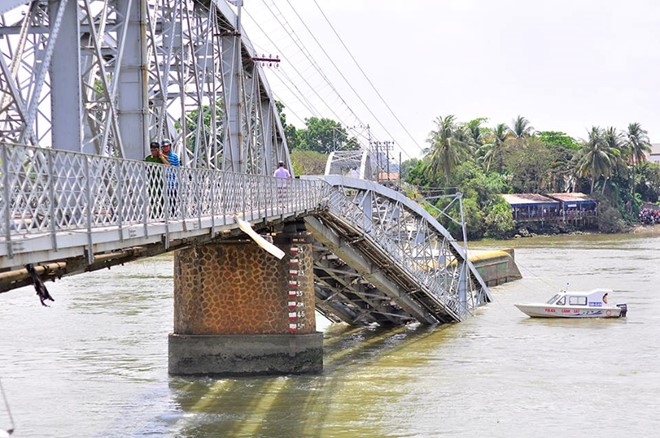 Society
Society

Deputy Prime Minister and Chairman of National Traffic Safety Committee Nguyễn Xuân Phúc yesterday .
 |
| The Ghềnh Railway Bridge in the southern province collapsed after it was rammed last Sunday morning by a barge carrying 800 tonnes of sand. — Photo zing.vn |
ĐỒNG NAI (VNS) — Deputy Prime Minister and Chairman of National Traffic Safety Committee Nguyễn Xuân Phúc yesterday called for a raft of measures to restore normalcy at the earliest after the collapse of a railway bridge on Sunday.
In doing so, he ruled out the feasibility of building a temporary bridge or floating bridge, which means all trains coming to the south will have to stop at the Biên Hòa Station in Đồng Nai Province, cutting short the main North-South rail link in the country.
The Ghềnh Railway Bridge in the southern province collapsed after it was rammed last Sunday morning by a barge carrying 800 tonnes of sand.
Phúc asked Deputy Minister of Transport Nguyễn Hồng Trường, leaders of the Đồng Nai People’s Committee and Việt Nam Railway Corporation to come up with solutions for addressing the accident’s consequences.
He also asked the provincial People’s Committee Chairman, who also chairs the province’s Traffic Safety Committee, to guide local authorities in carrying out rescue operations and restore waterway and railway operations to limit damage caused by the accident.
Relevant central and local agencies should mobilise all resources needed to quickly repair the bridge and restore the North-South railway route in the shortest time possible, he directed.
The Deputy PM reiterated earlier assessments that it would take at least three to four months for the nation’s main rail route to be fully restored.
He said local public security forces should protect the site, investigate the accident and impose stiff penalties on individuals and organisations violating marine traffic laws.
Following instructions from the government, the general director of Việt Nam Railway Corporation has initiated efforts to adjust the rail route schedule towards reducing losses and inconveniences for passengers.
The accident has stranded several trains at the Sài Gòn Railway Station, and stopped others coming in from the Northern and Central regions at the Biên Hòa Railway Station in Đồng Nai.
According to Việt Nam Railway Corporation, right after the bridge collapsed on Sunday, the schedules of 18 trains running in both directions were affected.
Officials said that 1,400 passengers had to be taken to Biên Hòa from Sài Gòn Station and 1,500 others brought the other way around using shuttle buses.
Hundreds other passengers decided to cancel their tickets and choose other forms of transportation. For now, train services on this section have been suspended. The Sài Gòn Railway Station has also announced that it has stopped accepting cargo consignments from yesterday.
Đỗ Đình Dược, deputy general director of the Sài Gòn Transport Company, said the company’s 11 wagons of cargo on its way to the North had to stop in Đồng Nai after the accident.
According to the management of Biên Hòa Railway Station, yesterday morning, the station received more than 3,000 passengers, as well as 1,000 tonnes of cargo sent to HCM City from Northern and Central regions.
Several consigners came to the site to unload their cargos, he said.
At the Biên Hòa Railway Station, hundreds of staff and police were mobilised to help passengers coming from Sài Gòn Railway Station in HCM City. Despite the situation, these operations were conducted smoothly.
Also yesterday, leaders from relevant agencies and Việt Nam Railway inspected the site and discussed plans for receiving passengers and cargo at Biên Hòa, Hố Nai, and Long Khánh Town stations.
Deputy Transport Minister Nguyễn Hồng Trường asked the POSCO company to prepare plans to salvage the tug boat that sank in the accident.
Another Deputy Transport Minister, Nguyễn Ngọc Đông, visited the accident site and said the ministry will direct the Việt Nam Railway Company to create a train schedule between Biên Hòa City and the northern region.
“This is a serious accident that has affecting marine traffic safety and seriously affected operations of the railway system,” Đông said.
Nguyễn Xuân Hòa, Chairman of Sài Gòn Railway, said at yesterday’s meeting that it would take at least three days to turn over the capsized barge. The plan to restore the bridge will be prepared later.
Salvaging the tow boat will be difficult, officials said, explaining that large-sized vessels cannot enter the river. Hence the current plan is to use a 3,000-tonnes barge and 200-tonnes crane to lift the boat.
The capsized barge, which had drifted 70 – 80 metres away from the collision site, has been secured to prevent collision with other boats or structures near the river.
Meanwhile, police in Đồng Nai Province have said procedures have been completed to start criminal proceedings against those responsible for the accident.
Nguyễn Văn Thọ, head of the staff bureau of the Đồng Nai Police Department, said that the barge crew will be prosecuted for violating marine traffic regulations and causing serious consequences.
“We will transfer documents to the Đồng Nai People’s Procuracy. But the first priority is to correct consequences of the railway bridge collapse,” Thọ said.
Yesterday morning, police arrested Trần Văn Giang, 36, of Bạc Liêu and Nguyễn Văn Lẹ, 28, of Sóc Trăng. Both the crew members had fled to Sóc Trăng after the accident happened. They have been brought to Đồng Nai for the investigation.
Giang and Lẹ are said to have jumped into the river and escaped as soon as the accident happened.
The collision sent the middle span and three pillars of the bridge tumbling into the water.
The 223-metre Ghềnh Bridge across the Đồng Nai River was built in 1902 by the colonial French administration. — VNS